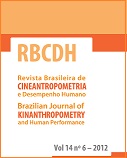EMG spectral analysis of incremental exercise in cyclists and non-cyclists using Fourier and Wavelet transforms
DOI:
https://doi.org/10.1590/1980-0037.2012v14n6p660Resumen
The aim of this study was to compare the electromyographic indices of fatigue (slope of median frequency) calculated with the fast Fourier transform (FFT) and wavelet transform (WT) in trained and untrained individuals during cycle exercise. A second objective was to compare the variance of the spectral parameters (median frequency - MF) obtained by the FFT and WT during exercise. Twelve cyclists and non-cyclists performed a maximal incremental test to determine the peak power (Wp) and electromyographic activity of the vastus lateralis (VL), rectus femoris (RF), biceps femoris (BF), semitendinous (ST) and tibialis anterior (TA). Mean values of median frequency, determined by the FFT and WT, were used for the spectral analysis of the electromyographic signals of the studied muscles. The analyzed parameters were obtained for each time period corresponding to 0, 25, 50, 75, and 100% of total duration of the maximal incremental test. No statistically significant differences were found in the values of MF and electromyographic indices of fatigue between the two techniques (FT and WT) both in the cyclists and non-cyclists group (P>0.05). Regarding the MF variance, statistically significant differences were found in all analyzed muscles, as well as in different time periods, both in the cyclists and non-cyclists groups when comparing the FFT and WT techniques (P<0.05). The WT seems to be more adequate to dynamic tasks, since it does not require the signal to be quasi-stationary, unlike the limitation imposed upon the use of the FFT.
Descargas
Publicado
Número
Sección
Licencia

Direitos Autorais para artigos publicados nesta revista são do autor, com direitos de primeira publicação para a revista. Em virtude da aparecerem nesta revista de acesso público, os artigos são de uso gratuito, com atribuições próprias, em aplicações educacionais e não-comerciais, desde que seja dada a atribuição. Esta obra foi licenciada com uma Licença Creative Commons Atribuição 4.0 Internacional - CC BY


